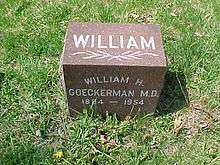Goeckerman therapy
Goeckerman therapy is a regimen for treatment of moderate to severe plaque psoriasis using a combination of crude coal tar and artificial ultraviolet radiation. It is a specialized form of light therapy.
First formulated in 1925 by American dermatologist William H. Goeckerman (1884–1954), Goeckerman therapy continues to be used due to its efficacy and safety profile.[1] Individual institutions have modified the Goeckerman regimen and developed their own protocols. Standard therapy includes use of 2–4% crude coal tar in a petroleum base applied daily to the psoriatic plaques. The minimum period of time for tar application is 2-hours, although it has been recognized that greater periods of time produce better results.[2] The patient is then exposed to broad-band ultraviolet B (UVB) radiation, although narrow-band UVB may also be used.[3] Laboratory studies have shown that the combination of coal tar and UV light reduces epidermal DNA synthesis.[4]
Modifications

In 1953, John Ingram, an English dermatologist, added topical anthralin paste to his Goeckerman regimen. This is known as the Ingram method.[5]
Cost
Recent publications have compared Goeckerman therapy with treatment with more expensive biologic agents.[6][7] Historically, Goeckerman therapy was performed as an inpatient treatment. However, today the treatment can be done with reduced cost as an outpatient. It has been stated by de Miguel et al., that an annual three-week outpatient course of Goeckerman treatment costs $10,000 to 12,000 but repeat treatment may be extended to two years with the use of a $2,000 home UVB treatment lamp.[6] The authors state that biologic therapy costs $22,000 to 59,000 per year.
Safety
Goeckerman regimens use crude coal tar, which contains polycyclic aromatic hydrocarbon, a carcinogen.[8][9] However, Goeckerman therapy is considered safe although use of tar may have the side-effects of contact dermatitis and mild local burning due to tar hypersensitivity. A retrospective study by Stern et al., of 1,373 patients concluded that there was an increase in skin cancers in those receiving repeated Goeckerman treatments compared to the control group.[10] This has been refuted by other authors, including Pittelkow et al., who state there has not been an increase in skin cancers among those treated compared to the general population[11] and Menter and Cran, who felt that the Stern study was too crude to have validity and felt a 10-year prospective study would be needed to confirm safety concerns.[2]
Efficacy
With the increased use of biologic medications in treatment of moderate-to-severe psoriasis there has been a shift away from Goeckerman therapy. A 2007 comparative study of psoriasis treatment found Goeckerman therapy to be more efficacious at 12-weeks than biologics.[12] It has also been successfully used in patients who have failed some biologic therapies.[13]
References
- Goeckerman, W. H. (1925). "The treatment of psoriasis". Northwest Med. 24: 229–231.
- Menter, Alan; Cram, David L. (July 1983). "The Goeckerman regimen in two psoriasis day care centers". Journal of the American Academy of Dermatology. 9 (1): 59–65. doi:10.1016/S0190-9622(83)70107-6. PMID 6886105.
- Lee, E.; Koo, J. (12 July 2009). "Modern modified 'ultra' Goeckerman therapy: A PASI assessment of a very effective therapy for psoriasis resistant to both prebiologic and biologic therapies". Journal of Dermatological Treatment. 16 (2): 102–107. doi:10.1080/09546630510033140. PMID 16019624.
- Bolognia, J L; Rapini, R; Jorizzo, J L (2003). Dermatology. London: Mosby. ISBN 9780323025782.
- Ingram, JT (12 September 1953). "The approach to psoriasis". British Medical Journal. 2 (4836): 591–4. doi:10.1136/bmj.2.4836.591. PMC 2029626. PMID 13082048.
- de Miguel, Rebeca; el-Azhary, Rokea (June 2009). "Efficacy, safety, and cost of Goeckerman therapy compared with biologics in the treatment of moderate to severe psoriasis". International Journal of Dermatology. 48 (6): 653–658. doi:10.1111/j.1365-4632.2009.04012.x. PMID 19538381.
- Dennis, Madison; Bhutani, Tina; Koo, John; Liao, Wilson (24 August 2011). "Goeckerman therapy for the treatment of eczema: a practical guide and review of efficacy". Journal of Dermatological Treatment. 24 (1): 2–6. doi:10.3109/09546634.2011.607794. PMC 3678985. PMID 21797807.
- Boström, CE; Gerde, P; Hanberg, A; Jernström, B; Johansson, C; Kyrklund, T; Rannug, A; Törnqvist, M; Victorin, K; Westerholm, R (June 2002). "Cancer risk assessment, indicators, and guidelines for polycyclic aromatic hydrocarbons in the ambient air". Environmental Health Perspectives. 110 Suppl 3: 451–88. doi:10.1289/ehp.02110s3451. PMC 1241197. PMID 12060843.
- Borska, Lenka; Andrys, Ctirad; Krejsek, Jan; Hamakova, Kvetoslava; Kremlacek, Jan; Palicka, Vladimir; Ranna, Dianna; Fiala, Zdenek (March 2010). "Genotoxic and apoptotic effects of Goeckerman therapy for psoriasis". International Journal of Dermatology. 49 (3): 289–294. doi:10.1111/j.1365-4632.2009.04258.x. PMID 20465666.
- Stern, RobertS.; Zierler, Sally; Parrish, JohnA. (April 1980). "Skin carcinoma in patients with psoriasis treated with topical tar and artificial ultraviolet radiation". The Lancet. 315 (8171): 732–735. doi:10.1016/S0140-6736(80)91231-3. PMID 6103156.
- Pittelkow, Mark R. (1 August 1981). "Skin Cancer in Patients With Psoriasis Treated With Coal Tar". Archives of Dermatology. 117 (8): 465–8. doi:10.1001/archderm.1981.01650080019020. PMID 7259240.
- Leon, Argentina; Nguyen, Alain; Letsinger, Julie; Koo, John (22 March 2007). "An attempt to formulate an evidence-based strategy in the management of moderate-to-severe psoriasis: a review of the efficacy and safety of biologics and prebiologic options". Expert Opinion on Pharmacotherapy. 8 (5): 617–632. doi:10.1517/14656566.8.5.617. PMID 17376017.
- Serrao, Rocco; Davis, Mark D.P. (February 2009). "Goeckerman treatment for remission of psoriasis refractory to biologic therapy". Journal of the American Academy of Dermatology. 60 (2): 348–349. doi:10.1016/j.jaad.2008.10.016. PMID 19150284.
Further reading
- Kortuem, Kimberly R.; Davis, Mark D. P.; Witman, Patricia M.; McEvoy, Marian T.; Farmer, Sara A. (22 September 2010). "Results of Goeckerman Treatment for Psoriasis in Children: A 21-Year Retrospective Review". Pediatric Dermatology. 27 (5): 518–524. doi:10.1111/j.1525-1470.2010.01124.x.